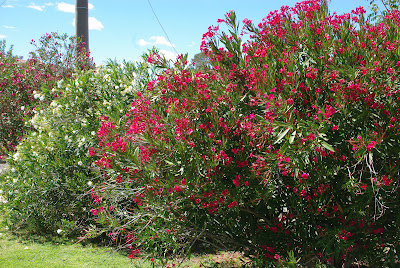 |
| Thyme, pennyroyal and chamomile growing in the pea straw. Initial watering was done by soaker hose once or twice a week. |
 |
| Newspaper and pea straw mulch kept the weeds down. |
 |
| The herb was spreading lawn spread nicely for a while. |
So much for the intentional plantings. Unexpectedly, the native violets planted as ground cover under the shrubs spread into the herb lawn, and spread, and spread, and keep spreading until the weather becomes too hot and dry for them. But they return with the first rain. One section of shrubs included a couple of creeping boobiallas, which also keep on spreading. Birds and wind spread seeds from nearby flowers onto the herb lawn and they grew, flowered, seeded and spread some more.
Noticing the way things were developing, I decided that the herb lawn would become a feral flower field; well, that was what was happening anyway, so I helped it along by scattering more seeds and encouraging my granddaughter to pop seed pods of love-in-a-mist.
Now the herb lawn/feral flower field is an ever-changing kaliedoscope of pennyroyal, pennywort, thyme, native violets, creeping boobialla, love-in-a-mist, poppies, calendulas, nasturtiums and amaranthus. This year, I added sunflowers to the mix; maybe they will self-sow or maybe I will need to replant some of the seeds I've saved.
Three or four times a year, after many of the flowers have grown and seeded, or when the pennyroyal becomes a little straggly after flowering, the area is mowed. The clippings are left scattered over the patch, where they act as mulch and contain seeds for next season's surprises.
During one drought summer, when restrictions prevented us from using any water to keep the plants going, the area was cut, covered with sugar cane mulch and left alone. As soon as it rained, seedlings began to emerge from beneath the mulch.
 |
| At the end of the drought the herb lawn was still covered with mulch, but the surrounding shrubs survived well. |

.JPG)
.JPG)








